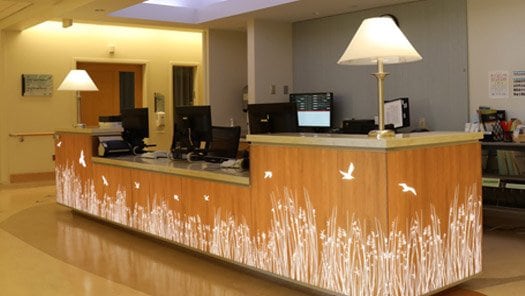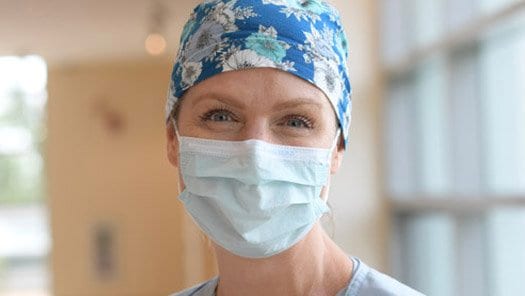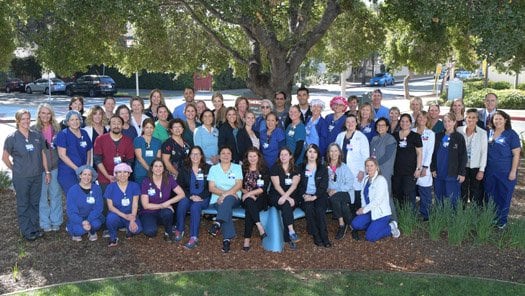Inpatient Experience

What We Are Measuring
The Hospital Consumer Assessment of Healthcare Providers and Systems (HCAHPS®) Survey is a national standardized survey instrument and data collection methodology to measure patients' perspectives of hospital care. All inpatients going home receive a survey within a week of their discharge.
HCAHPS measures nurse communication, doctor communication, responsiveness of hospital staff, pain management, communication about medicines, discharge information, care transition, cleanliness, quietness, overall hospital rating, and whether or not the patient would recommend the hospital.
These measures are publicly reported on Medicare.gov/care-compare, but lag by a year or more. We offer here our most recent 4-quarter rolling average.
How We Are Performing
Overall rating of hospital: Patients are asked to rate their overall experience at the hospital on a scale of zero (worst) to 10 (best). The scores shown below represent the percentage of patients that gave Santa Barbara Cottage Hospital the top ratings of nine or 10.
 Click to Enlarge
Click to Enlarge
Would recommend hospital: Patients are asked whether they would recommend this hospital to friends and family. The scores below show the percentage of patients who would “definitely recommend” Santa Barbara Cottage Hospital to their friends and family.
 Click to Enlarge
Click to Enlarge
What We Are Doing to Improve
Each patient care unit has a patient satisfaction team to review the data, investigate best practices and work to implement and sustain high levels of patient satisfaction. These best practices include:
- Hourly Safety Rounds
- Standardized bedside reporting to engage patients in their care
- Safety turn team to prevent pressure ulcers
- Teach-back education to ensure patients understanding of their condition, treatment and discharge instructions
- Leadership rounds
- Discharge phone calls to ensure patients wellbeing and address questions
- Room service to provide a wide variety meal choices
- Multi-disciplinary compassionate, relationship-based communication training
Emergency Department Experience

What We Are Measuring
The Press Ganey Emergency Department survey is used by more than 500 hospitals across the country which allows us to compare our performance to a wide variety of hospitals. All Emergency Department patients receive a survey either by mail or via email.
The survey measures patients and family members experiences with waiting times, nurses, physicians, tests, privacy, pain management, safety and security and hand washing.
How We Are Performing
Overall rating of Emergency Department: Patients are asked to rate their overall Emergency Department experience on a scale of zero (worst) to 100 (best). The scores shown below represent patients overall average rating.
 Click to Enlarge
Click to Enlarge
Would recommend Emergency Department: Patients are asked whether they would recommend this Emergency Department to friends and family on a scale of zero (worst) to 100 (best). The scores below show the average recommendation rating.
 Click to Enlarge
Click to Enlarge
What We Are Doing to Improve
Interdisciplinary patient process improvement teams in the Emergency Department review the data, investigate best practices and work to implement and sustain high levels of patient satisfaction. These best practices include:
- Patient care teams organized in pods to ensure timely and effective treatment
- Streamlined patient-centric admitting process
- Bedside reporting to engage patients in their care and treatment options
- Safety rounds to identify and address any issues in the moment
- Leadership rounds to ensure consistent and effective care
- Physician post-discharge phone calls to ensure patient wellbeing and address questions
- Multi-disciplinary compassionate, relationship-based communication training
Ambulatory Surgery Experience

What We Are Measuring
The Outpatient and Ambulatory Surgery Consumer Assessment of Healthcare Providers and Systems (OAS CAHPS) Survey is designed to measure the experiences of care for patients who have a surgery or procedure in an ambulatory surgery center.
The survey measures patients’ experiences on topics that are important when choosing an outpatient/ambulatory surgery provider for their surgery or procedure including:
- Communication and care provided by health care providers and office staff;
- Preparation for the surgery or procedure, and
- Preparations for discharge and recovery.
How We Are Performing
Overall rating of facility: Patients are asked to rate their overall experience at this ambulatory surgery facility on a scale of zero (worst) to 10 (best). The scores shown below represent the percentage of patients that gave this facility a rating of nine or 10.
 Click to Enlarge
Click to Enlarge
Would recommend facility: Patients are asked whether they would recommend this ambulatory surgery facility to friends and family. The scores below show the percentage of patients who would “definitely recommend” this facility to their friends and family.
 Click to Enlarge
Click to Enlarge
What We Are Doing to Improve
Process improvement teams regularly review this survey data, investigate best practices and work to implement systems to sustain high levels of patient satisfaction. These best practices include:
- Patient-centered pre-op registration / education process
- Post discharge phone call
- Multi-disciplinary compassionate, relationship-based communication training